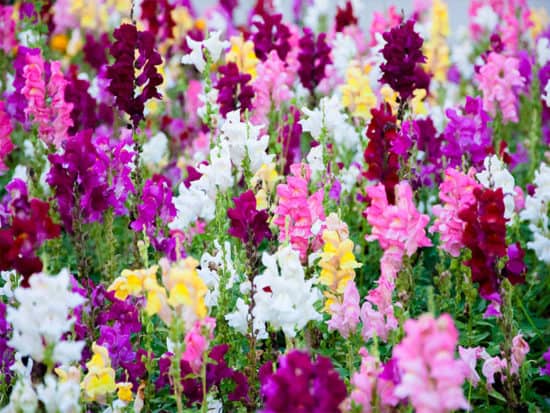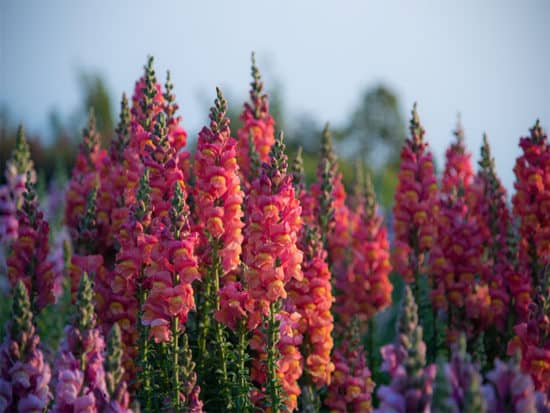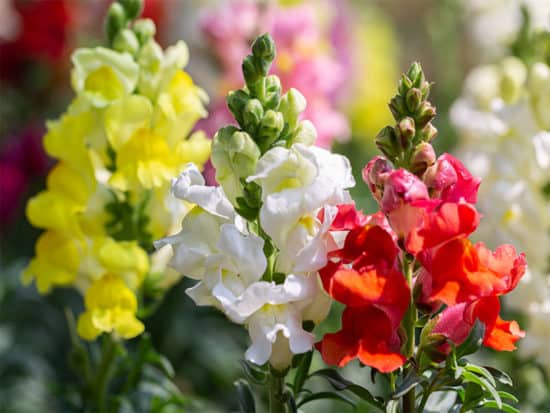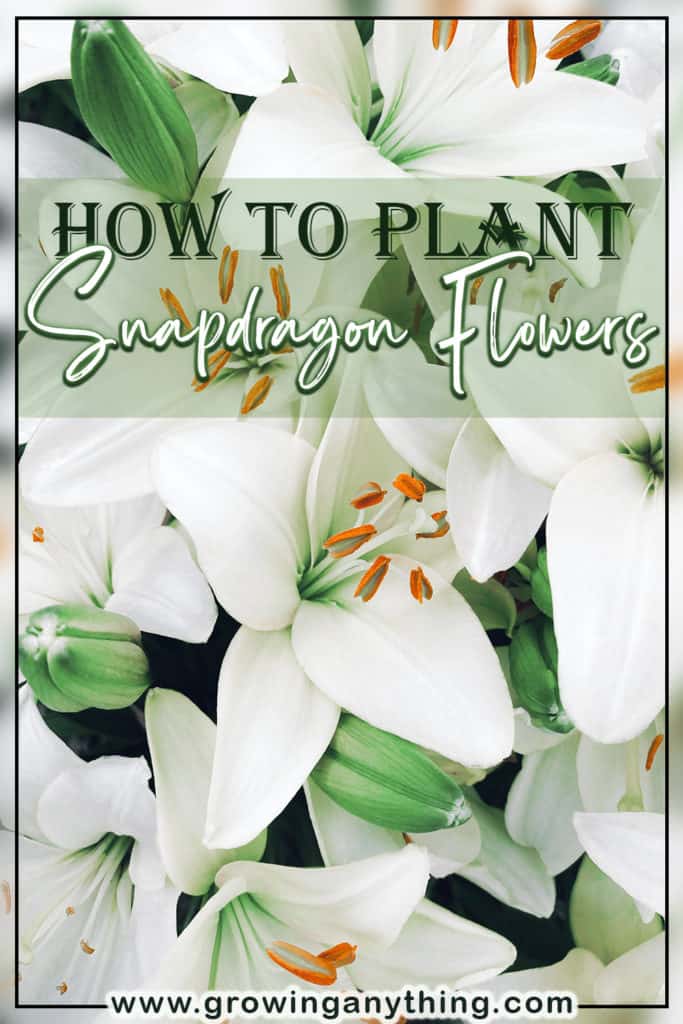How to Plant Snapdragon Flowers
If you want to make your garden more colorful and unique, you need to learn how to plant snapdragon flowers – the most beautiful and vibrant flowers out there. This gorgeous flower will keep all eyes on your garden since it can really stand out!
The usual blooming period of this flower in mid-summer. However, if you give it good growing conditions will keep it blooming throughout the year.
Before you decide to add this flower to your garden, you need to know more about how to properly plant it, take care of it, and what conditions are most suitable for it.
This will help you get started with the planting process more quickly. Also, it will help you grow the best snapdragon flowers for your garden. Without further ado, let’s get right into it!

Colorful Snapdragon Flower:
4 Interesting Facts About Snapdragon Flowers
There are so many interesting things about the snapdragon flower that you might want to know before you commit to adding it to your garden. Here are some of them:
The First Snapdragon Flowers
Usually, the first flower buds come from the bottom of the stalk and start going up slowly. This causes this flower to have a longer blooming period.
Even though you can see the flower growing in the heat of the summer as well, it will reach its peak in cooler weather and only if it has enough water available to it.
The Botanical Name
The botanical name for this flower is Antirrhinum majus. This means “snout-like” and is a reference to the shape of the flower itself.
Anatomy of the Flower
If you look into the anatomy of it, you will find that the flower has an upper and a lower lip, a stamen which includes the filament and anther, as well as a pistil that consists of the ovary, style, and the stigma.
Origin and Varieties
There are more than 25 different species of the snapdragon flower. It has been said that this flower is native to Asia and Europe. Nowadays, it can be found all over the world.
The reason for this is the beauty and vibrance of the flowers. At the same time, children love these flowers as they can make them open like a mouth if they press the sides of the flower.

Snapdragon Flowers in Nature:
Snapdragon Flower Varieties
Even though I have mentioned that there are more than 25 species of this flower, all of these species can be divided into three separate categories. Here are the three categories.
- Dwarf Snapdragon Flowers – these varieties cannot grow more than 10 inches tall. Some of the popular varieties that are part of this category are “La Bella” and “Floral Showers.”
- Tall Snapdragon Flowers – these varieties can reach a maximum height of 48 inches. If they reach their maximum height, they will require stalks to keep them standing. Some of the popular varieties that are part of this category are “Animation”, ”Rocket,” and “Madame Butterfly.”
- Trailing Snapdragon Flowers – these varieties can be found hanging out of containers and are known for their trailing tendencies. Some of the popular varieties that are part of this category are “Cascadia,” “Candy Showers,” and “Fruit Salad.”
How to Plant Snapdragon Flower Seeds?
Before you get to the planting, you first need to know when is the right time to plant the snapdragon flowers. As I have already mentioned, these flowers tend to thrive in cool weather while warmer weather can put a pause to their blooming.
If you want to get the most out of your flowers, you will need to plant the snapdragon seeds no more than 10 weeks before the frost period ends.
If you plant the seeds indoors, you will be able to transplant the flowers to your garden later on. Keeping them indoors for 8 weeks should be long enough. After those 8 weeks, or around the start of spring, you can transplant the flowers to the garden.
Now that I have covered the pre-planting facts that you need to know, I can tell you more about the process of planting. Here is what you need to do.
1. Choose the Containers and Start Preparing Them
The containers for your snapdragon flowers must come with drainage holes. This is because the flowers require soil that has good drainage and is rich in organic matter. The soil pH should be no less than 6.2 and no more than 7.0.
Choosing a spot in the garden that gets a lot of sunlight will also help the plant out. However, if you are starting out by planting the seeds at home, make sure that you put the container in a sunny spot.
2. Sowing the Seeds
In case you have not seen snapdragon seeds before, let me just tell you that they are very small. What this means is that you will not have to bury the seeds but rather sow them by sprinkling them on the soil surface. Once you sprinkle them, you can also press down on them to get them embedded into the soil.
3. Water Demands
This flower requires a lot of water during the germination of the seeds and the plant growing process. Make sure to water them regularly and do so with fresh water that is neither too hot nor too cold.
4. Seedling Thinning
When the seedlings get to a height of two inches, you will be required to thin them. Make sure that you place them no less than 6 inches apart because you will want to avoid competition between them.
5. Harden Off
This process is all about getting the flowers ready for transplantation. Making sure that the seedlings are hardened off will get them ready for climate change. Once you do this, you should feel free to get to the transplantation process.
Just a reminder, but before you get to the transplanting you should make sure that the spot in your garden is in direct sunlight for most of the day. This will benefit the flowers and will make them bloom much more.
How to Plant or Transplant Established Snapdragon Flowers?
I have covered everything that you need to know about planting snapdragon seeds. However, you also need to know how to plant these flowers when they are already established or when they are ready to be taken outdoors from the indoors. Let’s get to the list.
1. Prepare A Flower Bed in The Garden
When choosing a space for your snapdragon flowers in the garden, you need to keep in mind that they like to be in the sunlight during the day. They will also require soil that has good drainage and is rich in organic matter.
As I have previously mentioned, the pH of the soil should not exceed 7.0.
2. Plant the Flowers
When you have an established snapdragon on your hands, what you need to do is plant it in a hole that is a bit larger and deeper than the root ball of the flower. Make sure that the flower is upright and secure before you start filling in the hole with dirt.
If the flower is taller, you should also consider using a stick to keep it upright.
3. Regular Watering
Once you plant the snapdragons, make sure that you water them regularly. The area should be watered immediately after the planting as this will help get the soil settled.
Post-Planting Snapdragon Flowers Care
Even though snapdragons do not require that much maintenance, there are some things that you can do to keep the flowers in top shape and encourage blooming.
1. Light
During the spring, the snapdragons will require a lot of sunlight. They will bloom in partial shade as well, while full shade might cause the blooming to stop.
It is best if the snapdragons are planted in partial shade, in well-drained soil that is also rich in fertilizer. This will encourage them to stay vibrant and lively throughout the summer, while it will encourage new blooms to form in the fall.
Since they get established pretty quickly, you can also replace them every season with new ones. This could be an easy way to bring new colors to your garden.
2. Soil
I have already mentioned the type of soil that snapdragons like most – that is a neutral soil pH that does not exceed 7.0. Since they are quite short-lived, they do not feed heavily from the ground so there is no need to add fertilizer.
However, if you want to see your snapdragons reach their full potential, you might as well add some organic matter.
3. Water
Even though they are quite low-maintenance, there are some things that snapdragons need in order to excel and the most important thing on that list is water. An inch of water every week will be enough to keep the flowers blooming while overwatering might have a negative effect on the flower.
When planting, make sure that you do it at the plant’s crown and hold off on further watering as long as the water is still visibly wet.
4. Humidity and Temperature
Snapdragons tend to excel in cooler temperatures, anywhere between 40- and 70-degrees Fahrenheit would be best for them. However, when it comes to established flowers, they will be able to withstand even freezing cold weather.
The only thing that they require during the winter is enough water and maybe some pine straw mulch. It is best to have them covered during the coldest periods of the winter, or maybe you can transplant them to the indoors to protect them from the frost.
5. Fertilizer
If you are planning on using fertilizer for the snapdragons, make sure that it is an all-purpose, standard, and well-balanced fertilizer. Once you apply the dose of fertilizer, add some water to prevent nitrogen burns.
6. Deadheading
If you want your snapdragons to produce more blooms, you should try deadheading. You will need to locate the blooms that are already wilting and to remove them from the flower together with their seed pod. Then, there will be enough space for new blooms to grow.
In case an entire stalk of flowers is wilting, remove the entire thing are keep only the seeds since you will be able to use them to grow new snapdragons.
7. Additional Pruning
During the winter, you should consider pruning the snapdragons to encourage them to grow again in the spring. As I have mentioned, they are not long-lived flowers. So, you should not be disappointed if they start wilting after a season.
Usually, gardening experts suggest planting new snapdragons every year. You can keep the seeds from the old snapdragons and use them when the time is right. Some of the snapdragons will come back, but they might come back as hybrids rather than the original plant.
Nevertheless, having them in your garden will make it more colorful and vibrant so there is no going wrong with these amazing flowers.

Vibrant Colors of Snapdragon Flower
Snapdragon Flower Problems and Wilt Prevention
Although they are gorgeous flowers, snapdragons may be affected by many problems like diseases and bugs. In addition, there are several reasons why your snapdragons might be wilting.
Here are some of the most common problems that can occur with this plant and a brief explanation about how to prevent or cure them:
1. Available Water
Lack of water, as well as too much water, can lead to the flowers wilting. Both underwatering and overwatering can cause problems for the snapdragons.
It would be best if you add only some water to them every day during the summer, while in winter you should water them less frequently. A good idea might be to wait for the soil to dry before you give them any additional water.
2. Downy Mildew
If you are noticing that the leaves of your snapdragons are turning yellow and wilting, there could be an infection bothering the plant. Downy mildew is a common infection when it comes to snapdragons.
If your snapdragons have this infection, there are several things that you can do in order to get rid of it.
First, you need to treat the plant fungicide. Then, you need to sterilize the soil or transplant the flowers to a new pot or flower bed with new soil. Make sure that you remove all plant debris as well if you want to stop the fungus from spreading further.
3. Root Rot
A snapdragon’s root might rot might be caused by two things – Pythium, which attacks the roots, and Rhizoctonia, which attacks the plant base. If your plant suddenly collapses, then there is a good chance that there is root rot in it.
Unfortunately, root rot cannot be cured. If you want to prevent it, you should think more about the drainage of the flowers as well as the amount of water that you give them.
These are the two most likely causes of root rot.
4. Wilt Fungus
Wilt fungus can cause problems to gardeners when it comes to this type of plant. If your plants contract it, you can let it play out before destroying the plant and using a sterilizer on the place where the plant grew.
Since there is no cure for it, you are much better of letting the plant wilt and planting a new one instead of going through extra trouble trying to save it.
5. Pests and Insects
Snapdragons can be affected by other diseases and bacteria, as well as some pests. Mites, whiteflies, aphids, and mealybugs are often mentioned as problem-causers for snapdragons.
Usually, you can tell by the leaves if the flowers are affected by pests.
Use of Snapdragon Flowers
These flowers come in so many different colors and can be used for many different things. People often combine the ones with more pale colors with purple, red, or even pink flowers to make beautiful bouquets.
Professional gardeners love mixing the different snapdragon varieties to get hybrids. Nowadays, people use the many varieties available to create flower baskets, containers, and even flower walls.
Aside from the landscaping use, you can also use the snapdragon flowers for medicinal and culinary use. When it comes to medicine, the flowers contain a lot of edible oils that can extract from them and use to heal tumors and ulcers. The flowers have anti-inflammatory properties, which is why we use them so often.
As for culinary use, the snapdragon flowers contain a lot of vitamins. You can find them in a lot of salads and infusion teas.

Snapdragon flowers bouquet:
Conclusion
In conclusion, I would like to mention some of the must-know information about snapdragons. They will make your garden so much better if only you provide them with well-drained, fertilizer-rich soil, enough water, and enough sunlight.
These flowers are quite low-maintenance and can live in various conditions and temperatures. You will definitely not regret adding them to your garden as they are gorgeous, vibrant, and are sure to make you feel better when you look at them!

